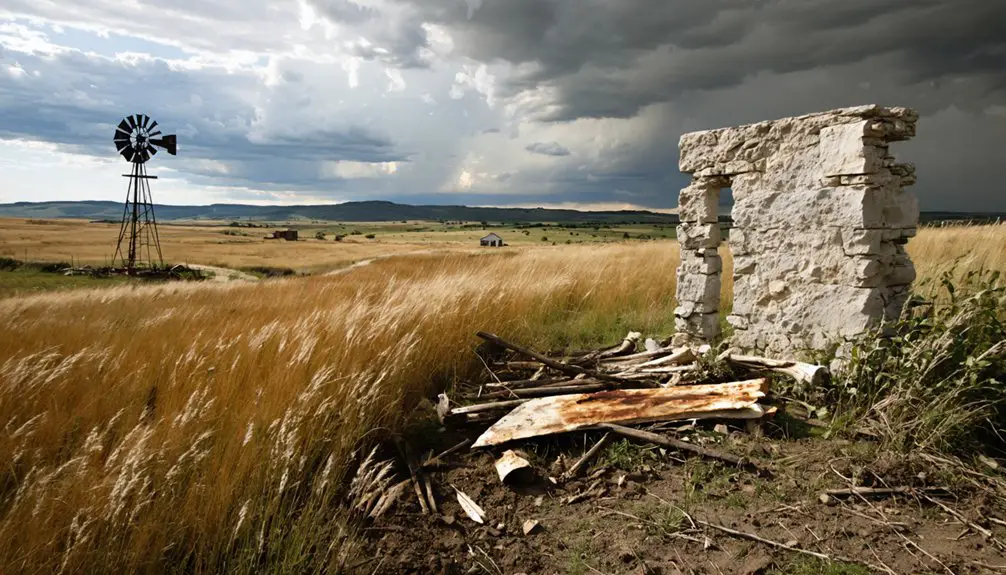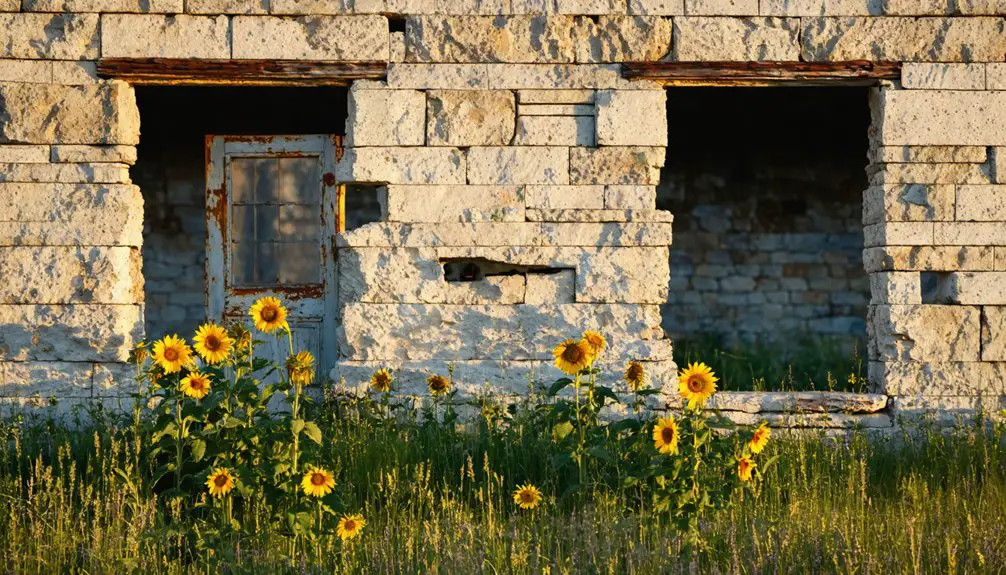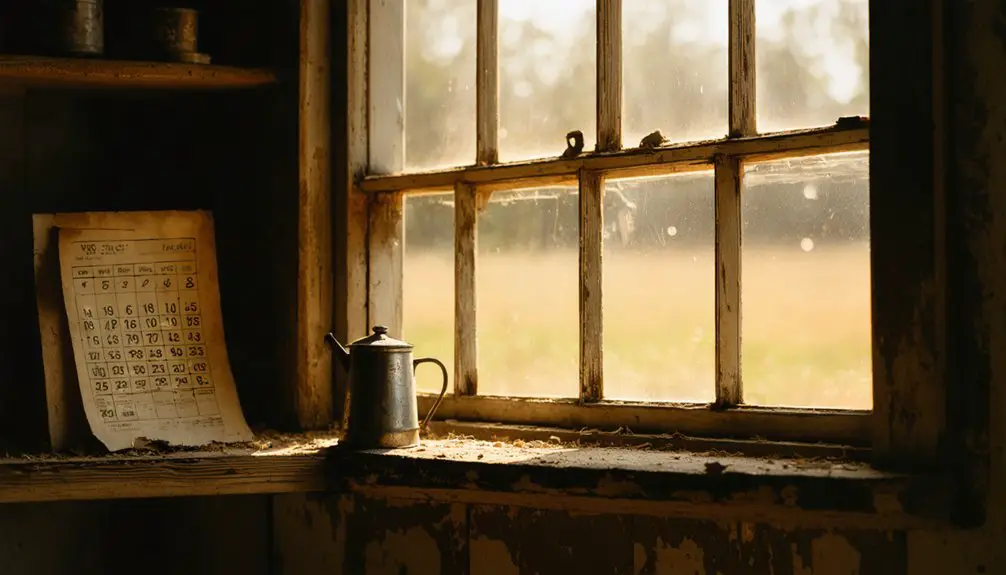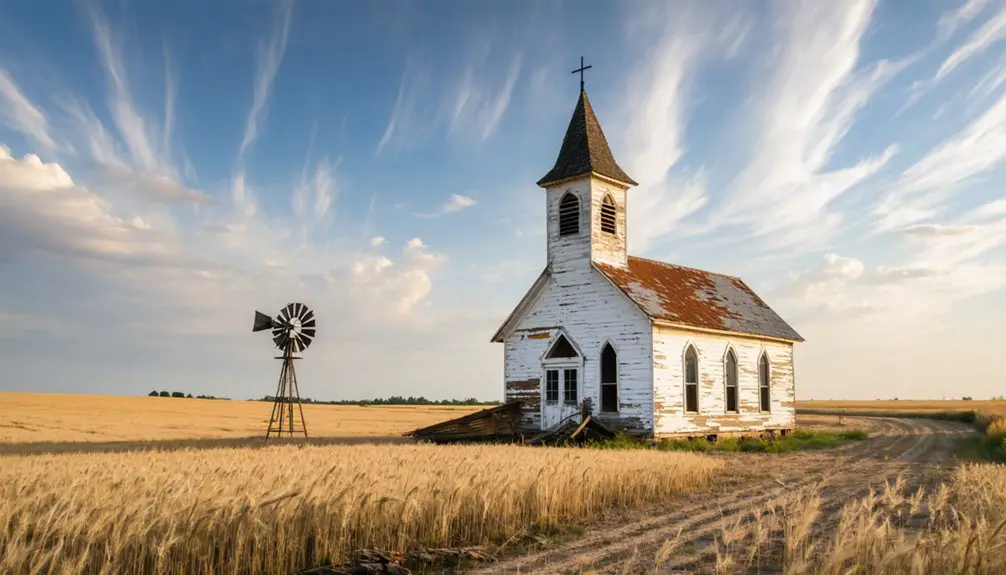You’ll find Ludell today as a quiet ghost town in Kansas that started as a thriving German settlement in 1875. The town, initially called Prag, went through several name changes before becoming Ludell in 1881. It flourished as an essential shipping point along the Chicago, Burlington and Quincy railroad line, featuring businesses and a distinctive stone building from 1891. Early settlers faced conflicts with Native Americans and harsh frontier conditions, while modern challenges gradually transformed this once-bustling prairie town.
Key Takeaways
- Ludell transformed from a thriving railroad shipping point in 1889 to a near-ghost town due to agricultural challenges and population decline.
- The town’s historic grain elevator from 1889 stands as a silent reminder of its once-prosperous railroad shipping heritage.
- Economic pressures during the Great Depression combined with modern farming technology led to widespread business closures and farm consolidations.
- Water depletion from the High Plains Aquifer and limited farmable land due to rocky terrain forced many farmers to abandon operations.
- Population steadily decreased as residents migrated to neighboring towns like Herndon and Atwood, leaving behind abandoned buildings and structures.
The Origins of a Prairie Settlement
When August C. Blume first arrived in May 1875, you wouldn’t have recognized the untamed prairie that would become Ludell. He led a wave of German settlers, including August Deitleff, Albert E. Lange, Charles Nast, and Antone Stermer, who established the area’s first homesteads.
Early settler interactions with Cheyenne Indians shaped the frontier experience, testing the resolve of these pioneering families. The settlement’s cultural influences were distinctly German, as immigrants tended to cluster in ethnic groups throughout Rawlins County. The area faced deadly conflicts in 1875 when Battle of Sappa Creek claimed the lives of twenty-seven Indians and two soldiers. Settlers earned money by collecting and selling buffalo bones, which could fetch up to $9 per ton.
In 1881, William H. Dimmick transformed the growing community by laying out the town site, naming it after his daughter Ludell. The settlement’s location was strategic, offering natural water sources and vegetation that proved essential for survival in the challenging prairie environment.
From Prag to Ludell: A Name’s Evolution
The story of Ludell’s name reflects the town’s journey from a simple prairie settlement to an established community.
You’ll find the town’s name significance began in 1876 when A.C. Blume established a post office called Prag. The name changed to Kelso City in 1879, then briefly to Danube in 1880 when the Kelso brothers relocated their store to Atwood. Like many Kansas counties in the territorial period, name changes were common as communities evolved and developed their identities.
William H. Dimmick, who shaped the town’s final layout, wanted to name it after his daughter Luella. However, the Postal Service rejected names ending in vowels, leading to several attempts at modification.
The community identity finally solidified with “Ludell” on May 9, 1881. Known simply as a woman’s name, Ludell became a crucial railroad shipping point along the Chicago, Burlington and Quincy line.
Life on the Frontier’s Edge
You’ll find early settlers in Ludell facing constant threats from Northern Cheyenne bands led by Dull Knife, prompting them to seek protection in stone buildings during their initial 1875 settlement.
Historical records show the Cheyenne’s presence in Kansas stemmed from their forced migration from Minnesota, where they were driven out by Sioux.
Your understanding of Ludell’s transformation deepens when you consider how the B&M Railroad’s arrival in 1889 sparked remarkable economic growth, leading to 25 new businesses and establishing the town as an essential shipping point.
The expansion into this region sparked severe conflicts as buffalo hunting decreased vital food sources for native tribes.
While Native American conflicts gradually subsided, you can trace how the town’s stone structures served as enduring symbols of the frontier’s challenges, even as Ludell developed into a thriving agricultural community.
Settlers Face Native Threats
Settlers arriving in northwest Kansas during the 1870s faced deadly confrontations with Native American tribes, particularly the Northern Cheyenne under Chief Dull Knife.
Native resistance intensified as tribes fought to protect their homeland from encroachment, leading to devastating raids and attacks near Ludell. Settler fears reached new heights after multiple violent incidents left 40 pioneers dead and their livestock scattered. Many families formed protection groups against the perceived tribal threats. Near Hundred Head Draw, dozens of cattle were killed during a violent raid in 1878.
You’ll find these three key developments shaped the conflict:
- The Battle of Sappa Creek in 1875 sparked escalated violence between cavalry and Cheyenne bands.
- Fort Wallace troops conducted aggressive patrols, often shooting natives on sight.
- The final major battle near Beaver Creek in 1878 brought significant settler casualties.
Survival demanded constant vigilance, with settlers building protective fences from local cottonwood and organizing community defense systems.
Railroad Brings Economic Growth
After decades of isolation on the frontier, Ludell’s fortunes changed dramatically when the B&M railroad arrived in 1889, ushering in an era of unprecedented economic growth.
Railroad expansion transformed your small frontier settlement into a bustling hub of commerce, attracting pioneering families like the Holstes and Kastens.
You’d find new economic opportunities springing up everywhere as residents established hardware stores, grain mills, and livestock stables.
The railroad’s presence meant you could now ship your crops and cattle to distant markets with ease, boosting agricultural production and trade.
Local industries flourished as transportation efficiency improved, creating jobs and fostering community development.
The iron horse brought more than just steel rails – it delivered the promise of prosperity, connecting you to the wider world and empowering your entrepreneurial spirit in the American heartland.
Much like the experience of other Kansas towns, fierce rate wars over cattle significantly reduced shipping costs for local ranchers.
Following the Interstate Commerce Act of 1887, railroad companies had to maintain fair and reasonable passenger rates for all travelers through Ludell.
Stone Building Offers Protection
While the railroad brought economic prosperity to Ludell in 1889, a single stone building constructed in 1891 stood as the town’s stronghold against frontier dangers. This unique stone refuge served multiple purposes, functioning as both a private club and a critical community defense structure against Northern Cheyenne raids.
You’ll appreciate how this building’s strategic features made it invaluable to settlers:
- Thick stone walls provided protection from gunfire, prairie fires, and harsh Kansas winters.
- Central location with connecting alleyways enabled quick access during emergencies.
- Sturdy construction offered the only reliable fortress in a region lacking military protection.
Without nearby railroads or military encampments, this stone sanctuary became essential for survival, especially when rumors of Indian uprisings kept settlers on high alert through restless frontier nights.
Native American Presence and Conflict

The Ludell area served as traditional territory for several Native American tribes, including the Pawnee, Cheyenne, and Sioux, who relied on the region’s buffalo herds and waterways like Sappa Creek for sustenance.
You’ll find evidence of their presence in landmarks such as Indian Bluff, where tribal lookouts once protected encampments, and Pawnee Grove, a significant gathering place for seasonal councils.
The relationship between settlers and Native Americans grew increasingly tense through the 1870s, culminating in violent conflicts like the Battle of Sappa Creek in 1875, where Northern Cheyenne fleeing Indian Territory clashed with U.S. cavalry near present-day Ludell.
Tribal Territory and Migration
Prior to widespread white settlement in the 1870s, Rawlins County served as home to several Native American tribes, including the Pawnee, Cheyenne, and Sioux.
Tribal movements across the region were complex and often driven by territorial conflicts between tribes and increasing pressure from white settlers.
Key events that shaped tribal territories in the area include:
- The Kanza tribe’s displacement from northern Kansas by the Ioway and Sauk tribes due to early firearms conflicts.
- The Northern Cheyenne’s dramatic 1878 exodus of 300 people from Indian Territory through Rawlins County.
- The forced relocation of the Kanza to Indian Territory by 1873.
These territorial shifts culminated in the October 1878 raid, marking the last major Native American conflict in Kansas as tribes fought to maintain their freedom and traditional ways of life.
Settler-Native American Relations
As tribes shifted across Rawlins County’s landscape, settler-Native American relations emerged as a complex web of conflict and uneasy coexistence.
You’ll find that early homesteaders like August C. Blume encountered roving bands of Cheyenne, leading to tense cultural exchanges and challenging land negotiations. The Northern Cheyenne, under Dull Knife’s leadership, conducted raids near Ludell that claimed up to 15 settler lives, including women and children.
In response, you’d have seen settlers using local cottonwood trees to build defensive structures and extensive fencing around their properties.
While some treaties attempted to establish boundaries and relocate tribes to reservations, the tension remained palpable.
Even as Ludell developed with livestock stables and grain mills, settlers maintained constant vigilance against potential raids, highlighting the precarious balance of frontier life.
Railroad Prosperity and Economic Growth
During the late nineteenth century, Ludell’s fortunes changed dramatically when the Chicago, Burlington and Quincy Railroad constructed tracks through the town, establishing it as a major shipping point in the region.
The railroad expansion transformed Ludell into a bustling hub of commerce and trade, creating economic interdependence with neighboring communities.
You’ll find that Ludell’s prosperity peaked before the Great Depression, driven by:
- Thriving agricultural operations, particularly dairy farming on fertile pasturelands
- Merchant activity that flourished due to improved transportation networks
- Enhanced distribution of goods and services throughout the area
The railroad’s presence spurred infrastructure development and population growth, making Ludell a crucial transportation center.
This golden age of railroad prosperity positioned the town as a significant player in regional commerce, though challenges would eventually emerge.
The Stone Building’s Mystery

Standing proudly amid Ludell’s historic landscape, the town’s sole stone building represents an architectural marvel that has intrigued locals and historians for generations.
You’ll find this three-story structure, built from native rubble stone, showcasing the architectural significance of late 19th-century Kansas commercial design. While originally serving as a cheese factory in 1898, the stone building later transformed into a private club and residential space, adapting to the community’s changing needs.
Inside, you’ll discover fascinating features: robust timber framing, dark oak cabinetry, and concealed storage compartments beneath display windows.
The building’s construction speaks to settler ingenuity, using locally sourced materials and repurposed elements from other historic structures. Despite several preservation attempts since the 1970s, this remarkable piece of Kansas history continues to weather time’s passage.
Agricultural Changes and Population Decline
While Ludell initially thrived as an agricultural hub, the town’s decline stemmed from complex geographic and economic pressures that transformed farming practices in Rawlins County.
You’ll find three major factors that drove Ludell’s agricultural decline:
- Limited farmable land due to Beaver Creek and rocky bluffs forced expansion away from town.
- Rising operational costs jumped from $130,000 to $300,000, while wheat prices plummeted to $3.37 per bushel.
- Water depletion from the High Plains Aquifer stressed farming operations.
The population migration accelerated as farmers chose neighboring Herndon and Atwood for shipping crops.
Farmers increasingly abandoned Ludell, shifting their grain shipments to the more viable markets of Herndon and Atwood.
Even Ludell’s distinction as home to the county’s largest dairy operation couldn’t halt the exodus.
As farms consolidated and grew from 640 to 770 acres, many operators faced tough choices, with some earning as little as $8,451 annually by 2015.
Daily Life in Early Ludell

As the first settlers established roots in Ludell in 1876, you’d find a close-knit community shaped by German and Czech immigrants who brought their cultural traditions to the Kansas prairie.
Your daily routines would revolve around the local post office run by the Blume family, where you’d collect mail and exchange news with neighbors. Community gatherings centered on the church northwest of town, serving as both a spiritual haven and social hub.
You’d witness the rhythms of frontier life unfold through seasonal agricultural work, trading at the Kelso brothers’ store, and watching trains come and go at the Burlington railway station.
The shared challenges of prairie living fostered strong bonds among settlers, as they adapted their Old World customs to create a distinctive small-town culture on the open plains.
Legacy of a Lost Kansas Town
The once-thriving community of Ludell now stands as a reflection of the dramatic changes that reshaped Kansas’s rural landscape throughout the 20th century.
Like countless Kansas prairie towns, Ludell’s quiet streets tell the story of rural America’s great transformation.
You’ll find this ghost town’s story echoes the broader pattern of rural decline that transformed America’s heartland. The elements that drove Ludell’s fate include:
- Geographic challenges from unfarmable rocky bluffs and Beaver Creek’s erosion of arable land
- Economic pressures during the Great Depression that devastated local businesses
- Technological advances that reduced the number of farmers needed to work the land
What remains of Ludell serves as a powerful reminder of how external forces can reshape communities.
The 1889 grain elevator still stands as a monument to the town’s agricultural heritage, while the abandoned buildings tell the story of a once-vibrant farming community that couldn’t survive the shifting tides of progress.
Frequently Asked Questions
What Games and Entertainment Activities Were Popular Among Ludell’s Early Settlers?
You’d find settlers gathering for card games, checkers, storytelling, and hunting, while outdoor activities like horseback riding, ice skating, and community picnics brought everyone together for entertainment.
Did Any Famous Outlaws or Historical Figures Ever Visit Ludell?
Truth is stranger than fiction, but you won’t find outlaw sightings or historical figures in Ludell’s story. Records show no famous bandits or notable personalities ever visited this farming-focused railroad town.
What Were Typical Wages and Prices in Ludell During Its Peak?
You’d earn about $1-2 per day as a farm worker, while paying around 3-5 cents per pound for flour and 5-7 cents for sugar during Ludell’s peak wage history and price comparison.
Were There Any Documented Paranormal Experiences in Abandoned Ludell Buildings?
While you might be skeptical, there aren’t direct paranormal sightings documented specifically in Ludell’s buildings. However, you’ll find nearby Stull Cemetery’s ghost stories include shadow figures in abandoned structures.
What Traditional German Customs and Festivals Were Celebrated in Early Ludell?
You’ll find German traditions like Erntedankfest harvest festivals, St. Martin’s Day lantern processions, church picnics, and festive gatherings with Liederkranz singing societies, traditional polka dances, and seasonal beer celebrations.
References
- https://krex.k-state.edu/server/api/core/bitstreams/47bf7632-6fbd-4376-940d-2cd11dd5d893/content
- https://fhsuguides.fhsu.edu/kansasheritage/rawlinscounty
- https://fhsuguides.fhsu.edu/kansasheritage/shermancounty
- https://legendsofkansas.com/kansas-ghost-town-list/
- https://legendsofkansas.com/rawlins-county-kansas/
- https://legendsofkansas.com/reno-county-kansas/
- https://americanarchive.org/catalog/cpb-aacip-b47f722c560
- http://www.kansastowns.us/hdkt/townl.html
- http://www.kansashistory.us/kscounties.html
- https://kids.kiddle.co/Ludell



